What is JAMstack?
JAMstack is a modern web development architecture that decouples the frontend from the backend, improving performance, security, and scalability. The acronym JAM stands for:
- JavaScript: The dynamic functionality layer (React, Vue, Svelte, etc.).
- APIs: Server-side operations handled via APIs.
- Markup: Pre-rendered HTML and static files served via a CDN.
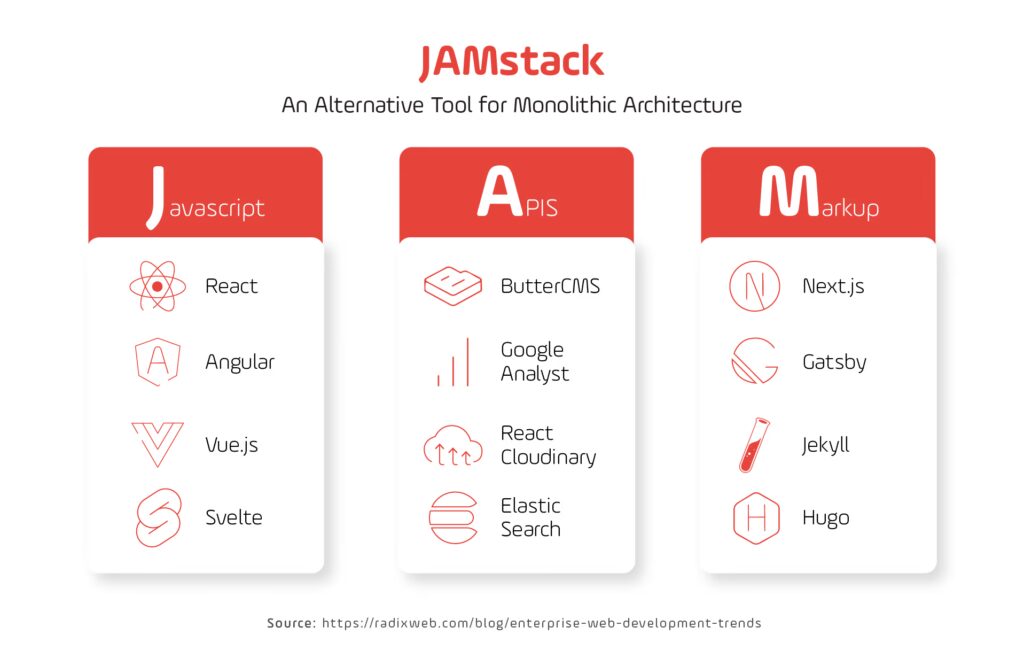
The Origins of JAMstack and Its Growth
The concept began to gain traction around 2015, when developers recognized the limitations of traditional monolithic web architectures. The need for faster page load times, better security, and improved scalability led to the development of a new approach that relied on pre-rendered content and APIs rather than complex backend logic. **Netlify, one of the pioneers of JAMstack, popularized the term and played a key role in bringing serverless and headless architectures into mainstream adoption.
Over the past decade, JAMstack has witnessed exponential growth. According to the 2024 State of JAMstack Report, adoption has surged by over 50% annually, with more than 65% of developers actively using JAMstack technologies in production environments. Companies like Nike, PayPal, and Airbnb have integrated JAMstack into their development workflows, citing better performance, enhanced security, and improved developer experience as major benefits.
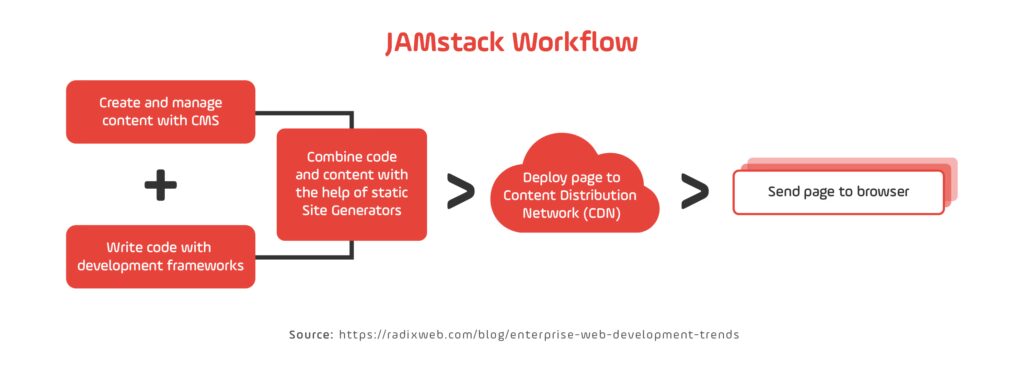
Why Developers Must Know JAMstack in 2025
- Performance is a Business Priority – Studies show that 53% of users abandon a website if it takes more than 3 seconds to load. JAMstack’s pre-rendered content, served through global CDNs, ensures ultra-fast page loads, which directly impacts conversion rates and SEO rankings.
- Security Without Complexity – Since JAMstack sites do not rely on traditional servers or databases, attack surfaces are drastically reduced. This eliminates common vulnerabilities such as SQL injections, DDoS attacks, and unauthorized access.
- Scalability and Cost Efficiency – its applications scale effortlessly with CDN-based hosting solutions like Vercel, Netlify, and Cloudflare Pages. This eliminates the need for complex backend scaling strategies and significantly reduces infrastructure costs.
- Better Developer Experience – it promotes a decoupled approach, allowing developers to work independently on the frontend and backend. This improves efficiency, enables faster feature deployments, and fosters a more collaborative workflow among teams.
- Seamless API and Headless CMS Integration – The rise of headless CMSs like Contentful, Strapi, and Sanity has made JAMstack an attractive choice for businesses that require flexible and scalable content management solutions.
Why is JAMstack Popular in 2025?
In 2025, JAMstack is more than just a trend—it has become the gold standard for modern web applications. With the increasing demand for faster load times, better security, and scalability, JAMstack is being widely adopted by enterprises and startups alike. Companies are moving away from traditional monolithic architectures to embrace API-first and serverless computing. This shift aligns with the evolution of modern JavaScript features, as discussed in our article on Modern JavaScript Features Every Developer Should Master in 2025.
Additionally, developer experience has significantly improved with the adoption of JAMstack. Tools such as Vercel, Netlify, and Cloudflare Pages now offer one-click deployments, built-in continuous integration, and serverless functions. This shift has made it a developer-friendly and cost-effective choice for businesses of all sizes.
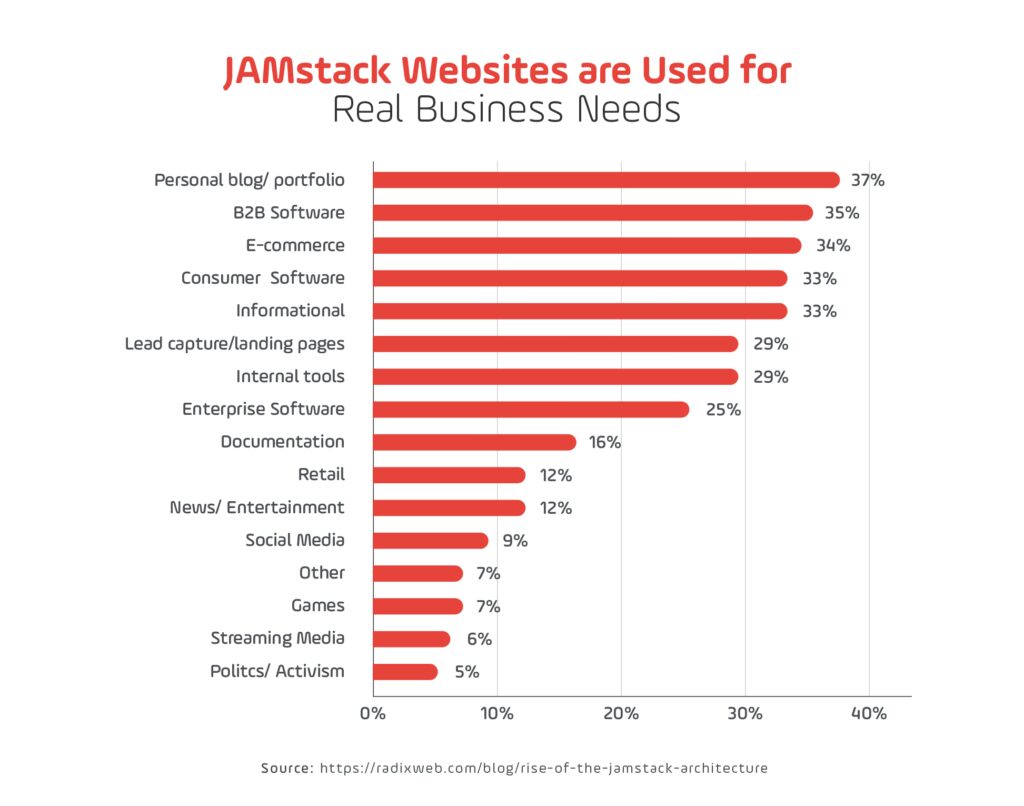
Why React is a Perfect Fit for JAMstack in 2025
React continues to dominate the frontend ecosystem, and its compatibility with JAMstack has only strengthened. Here’s why:
1. Component-Based Architecture
React’s modular approach allows developers to build reusable UI components, making development more efficient and scalable. This aligns perfectly with JAMstack’s decoupled approach, allowing developers to integrate microservices and headless CMS solutions seamlessly. React components enable faster iteration cycles, as teams can develop and test individual components independently before integrating them into the larger application.
By structuring applications into smaller, reusable pieces, developers can significantly reduce code duplication and maintenance overhead. The ability to create self-contained UI components ensures that applications remain modular, flexible, and adaptable to changes in design or functionality.
- Example: Shopify adopted a JAMstack approach with React to allow for customizable storefronts, ensuring high performance while maintaining design flexibility.
- Comparison: Unlike traditional templating engines such as Handlebars or PHP-based CMSs, React allows dynamic UI rendering while keeping state management efficient.
2. Server-Side Rendering (SSR) & Static Site Generation (SSG)
With frameworks like Next.js and Remix, React applications can now leverage hybrid rendering strategies. SSG enables blazing-fast performance by pre-rendering content, while SSR provides flexibility for dynamic content, improving SEO and user experience. The combination of Incremental Static Regeneration (ISR) in Next.js ensures that applications can refresh content dynamically without requiring full re-renders, optimizing both user experience and backend efficiency.
This hybrid rendering approach means developers no longer need to choose between performance and real-time data updates—they can enjoy the best of both worlds. Whether dealing with static marketing pages, dynamic dashboards, or real-time social feeds, JAMstack-powered React applications can optimize rendering techniques accordingly.
- Example: The Washington Post utilizes Next.js Incremental Static Regeneration (ISR) to update breaking news articles dynamically while caching older content for speed.
- Comparison: Traditional CMS-based sites regenerate content at request time, increasing server load, whereas JAMstack + React-based solutions reduce redundancy and improve time-to-first-byte (TTFB).
3. API-Driven Development
JAMstack thrives on APIs, and React’s ability to consume data from APIs (REST, GraphQL, or serverless functions) makes it a perfect fit. The rapid adoption of GraphQL as an API standard has transformed how React applications fetch and manage data, allowing developers to retrieve only the necessary data and avoid unnecessary payloads.
API-driven development enables faster integrations with third-party services, such as payment gateways, analytics tools, and machine learning models, ensuring that applications remain adaptable to evolving business needs.
- Example: Netflix optimizes its GraphQL API with React to serve different levels of content granularity depending on whether users are on mobile, TV, or web.
- Comparison: REST APIs often return excessive or insufficient data, whereas GraphQL allows React applications to fetch only the required fields, reducing network payloads and improving efficiency.
4. Performance Optimization
React has made tremendous performance improvements with concurrent rendering, automatic batching, and React Server Components. When combined with JAMstack’s CDN-first delivery, the result is near-instantaneous load times. By leveraging techniques such as code-splitting, lazy loading, and server-side rendering, React-based JAMstack applications can significantly reduce initial page load times.
Performance optimization extends beyond rendering speed—React applications can now handle large-scale user interactions, background processing, and AI-enhanced personalization without compromising speed or responsiveness.
- Example: TikTok’s web platform saw a 35% increase in performance after transitioning to React with JAMstack principles, implementing lazy loading and CDN caching.
- Insight: React 19’s automatic batching and enhanced hydration further optimize rendering cycles, leading to faster interactions and reduced render-blocking scripts.
5. Edge Computing Integration
React applications can now take advantage of edge functions through Netlify, Vercel, and Cloudflare Workers, allowing for lightning-fast responses closer to the user’s location. Edge computing significantly reduces response times by processing requests at the network edge instead of a centralized server, improving real-time user experience for global applications.
- Example: E-commerce platforms like Shopify and BigCommerce integrate React with edge functions to display localized pricing and inventory based on user geolocation.
- Further Development: Edge functions allow dynamic computations at the network edge, improving load times for global audiences without requiring repeated API calls.
Key Trends in 2025
1. Edge Functions & Serverless Architectures
JAMstack applications are increasingly leveraging edge computing and serverless functions to improve performance and scalability. Edge functions allow computations to run closer to users, reducing latency and improving real-time responsiveness. This is particularly useful for personalization, real-time analytics, and AI-powered features.
- Example: Cloudflare Workers and Netlify Edge Functions are enabling companies to execute backend logic without dedicated servers, leading to faster load times and cost efficiency.
- Stat: According to Gartner, by 2026, 75% of enterprise-generated data will be processed at the edge, making edge computing a key factor in JAMstack’s evolution.
2. Headless CMS Adoption is Skyrocketing
As businesses move toward omnichannel content strategies, headless CMS solutions have become the go-to choice. These platforms separate content management from content delivery, allowing seamless integration with various frontends.
- Example: Storyblok and Sanity offer real-time collaboration, structured content management, and GraphQL support, making them preferred options for JAMstack developers.
- Trend: The demand for headless CMSs is projected to grow by over 25% annually, as companies prioritize scalability, flexibility, and API-driven workflows.
3. Progressive Web Apps (PWAs) & Offline Support
PWAs are becoming a standard for mobile-first web experiences, with features like offline mode, push notifications, and home screen installation. Its pre-rendered pages and service workers enhance PWA performance, making applications more responsive and engaging.
- Example: Twitter Lite, a PWA built on JAMstack principles, reduced data usage by 70% and improved user engagement in emerging markets.
- Why It Matters: With Google prioritizing mobile-first indexing, JAMstack PWAs provide a competitive SEO advantage while delivering a native app-like experience.
4. AI-Driven Personalization & Dynamic Content
AI-powered personalization is being integrated into JAMstack applications, enabling real-time content customization, predictive analytics, and AI-driven search recommendations.
- Example: eCommerce sites using AI-powered recommendations through platforms like Algolia and Segment are seeing higher conversion rates by delivering personalized content.
- Industry Shift: As AI capabilities expand, static sites are becoming more dynamic, blending pre-rendered performance with real-time AI-powered customization.
5. Enhanced Security & Authentication
Security is a growing concern, and JAMstack’s architecture inherently improves protection against common web vulnerabilities. Authentication mechanisms are evolving with passwordless logins, OAuth 2.0, and blockchain-based identity verification.
- Example: Auth0 and Firebase Authentication enable secure user management without maintaining traditional servers.
- Trend: With the rise of zero-trust security models, JAMstack applications are integrating multi-factor authentication (MFA) and biometric logins to enhance security.
For more in-depth details, visit Smashing Magazine’s guide on JAMstack and React’s official documentation.
Enterprise Applications
Why Enterprises Are Adopting JAMstack
Large-scale enterprises are increasingly embracing JAMstack due to its performance, security, and scalability advantages. Unlike traditional monolithic applications, JAMstack offers a lighter, more agile architecture that enables teams to build and scale applications with greater efficiency.
- Stat: A 2024 Forrester report found that 70% of enterprises are either planning or already implementing JAMstack architectures to modernize their web platforms.
- Key Benefit: Enterprises adopting JAMstack experience faster development cycles, lower operational costs, and improved security compliance.
Enterprise Case Study: Nike’s Transition to JAMstack
Nike recently overhauled its eCommerce platform by adopting JAMstack, reducing server costs by 40% and improving page load times by 60%. By leveraging Next.js with a headless CMS, Nike streamlined its online shopping experience, providing real-time updates and optimized mobile performance.
- Result: Increased conversion rates due to faster page speeds and improved UX.
SEO Benefits of JAMstack Websites
Why it Outperforms Traditional Web Architectures in SEO
It provides significant SEO advantages due to its focus on speed, structured data, and optimized rendering techniques. Search engines like Google prioritize page experience metrics, and its pre-rendered approach ensures superior performance in these areas.
- Stat: According to Google’s Core Web Vitals report, websites that load within 2.5 seconds or less see a 24% increase in engagement rates.
- Stat: 64% of all web traffic comes from mobile devices, making mobile performance a key ranking factor (Statista).
- Example: Websites built with Next.js and a headless CMS have achieved over 80% improvement in Lighthouse scores for SEO, accessibility, and performance.
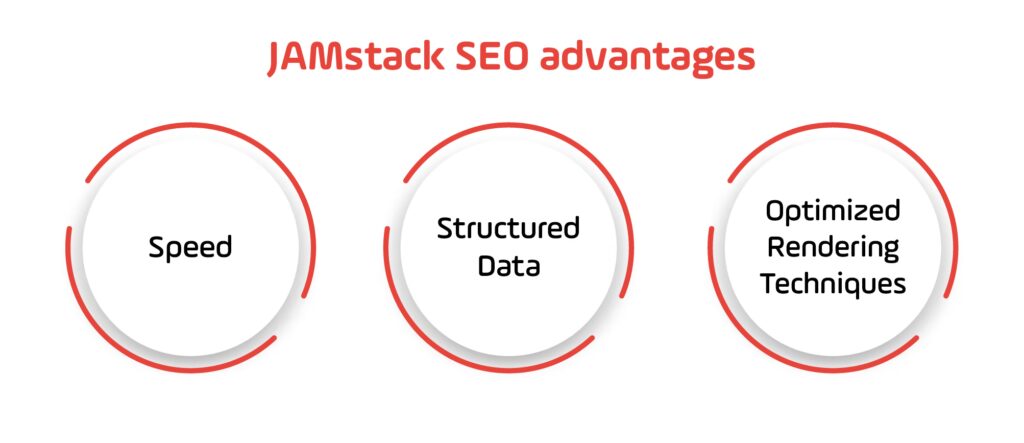
How it Optimizes for Core Web Vitals
Google’s Core Web Vitals include three key performance indicators:
- Largest Contentful Paint (LCP) – Measures loading performance.
- First Input Delay (FID) – Evaluates interactivity.
- Cumulative Layout Shift (CLS) – Tracks visual stability.

JAMstack sites excel in these areas by:
- Reducing render-blocking JavaScript through static generation.
- Leveraging CDNs for faster content delivery.
- Optimizing images and assets with modern formats like WebP.
- Implementing Incremental Static Regeneration (ISR) to serve up-to-date content without compromising page speed.
Mobile-First SEO
With Google’s Mobile-First Indexing, ensuring that websites are optimized for mobile devices is crucial. Since JAMstack sites are lightweight, pre-rendered, and CDN-distributed, they naturally align with mobile-first SEO strategies.
- Stat: Google’s data shows that mobile-friendly websites rank higher, and sites that are not mobile-optimized see a drop in rankings by up to 30% (Google Mobile-First Indexing).
- Example: A leading eCommerce brand migrated to JAMstack and saw a 40% increase in organic mobile traffic due to faster load times and improved UX.
Technical SEO Advantages
- Pre-rendering for improved crawlability – Search engines prefer static, pre-rendered pages over JavaScript-heavy dynamic sites that require client-side rendering.
- Faster indexing – JAMstack’s static content delivery helps reduce Googlebot crawl budget, ensuring faster indexing.
- Better Time-to-First-Byte (TTFB) – Sites using serverless hosting and CDNs see an 18% increase in organic traffic due to reduced TTFB (Bejamas JAMstack SEO Guide).
- Improved Core Web Vitals metrics – Sites with Next.js and ISR achieve higher scores for LCP, FID, and CLS, which are key Google ranking factors.
Case Study: How Smashing Magazine Improved SEO with JAMstack
Smashing Magazine transitioned from a WordPress-based site to a JAMstack architecture with Hugo and Netlify, leading to:
- 85% improvement in page load speeds (Bejamas JAMstack SEO Guide).
- 30% increase in organic traffic due to improved SEO rankings (StaticMania JAMstack SEO Guide).
- Reduction in bounce rates as pages loaded almost instantly (Google Core Web Vitals Report).
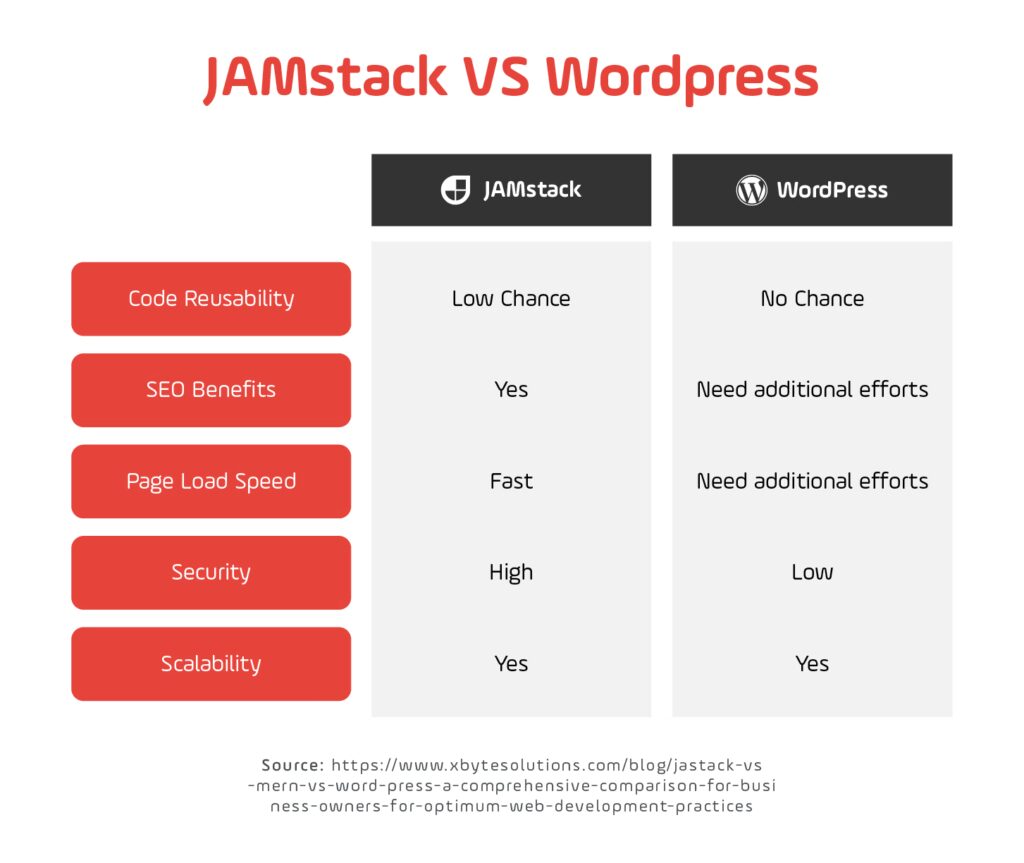
Structured Data and SEO Advantages
- Static site generators like Gatsby and Next.js support Schema.org markup, helping search engines better understand content.
- It enables fast, indexable pages, increasing visibility in search engine results pages (SERPs).
- Example: News websites and blogs have seen significant improvements in rich snippets and featured snippetsdue to clean, structured data implementation.
Additional Case Studies and Reports
- Nike’s JAMstack Adoption: Nike successfully transitioned to JAMstack to enhance performance and user experience, reducing page load times by 60% (Netlify Case Studies).
- Forrester Research on Adoption: A 2024 Forrester Report highlights that 70% of enterprises are either planning or already implementing JAMstack architectures (Forrester Research).
- eCommerce Case Study: An online store using JAMstack saw a 35% increase in search rankings after switching to static generation and image optimizations (Bejamas JAMstack SEO Guide).
With search engines focusing more on performance and usability, JAMstack provides a future-proof solution that aligns perfectly with Google’s ranking factors. Companies that adopt pre-rendering, structured data, and CDN optimization will see improved SEO rankings and higher user engagement.
Challenges and Limitations
While it offers significant advantages in speed, security, and scalability, it is not without its challenges. Developers and businesses considering it must understand its limitations and potential drawbacks before making the transition.
1. Handling Dynamic Content and Real-Time Updates
JAMstack is inherently static-first, meaning that generating real-time or highly dynamic content can be more complex compared to traditional server-based architectures.
Challenges:
- Websites relying on frequent data updates (e.g., stock prices, live sports scores, user-generated content) can face delays in content delivery.
- Static site generators (SSGs) require regeneration of static pages, which may not be ideal for applications that need real-time updates.
Solutions:
- Use Incremental Static Regeneration (ISR) in Next.js to update specific pages without rebuilding the entire site (Next.js ISR Docs).
- Integrate serverless functions or APIs (e.g., AWS Lambda, Netlify Functions) to handle real-time data fetching.
- Implement hybrid rendering strategies combining static and dynamic rendering based on user needs.
2. Complexity in Setup and Maintenance
JAMstack introduces a new paradigm that requires different tools and workflows compared to traditional CMS-based development.
Challenges:
- Developers must be familiar with CDN deployments, API integrations, and headless CMSs, which can have a steep learning curve.
- Content editors may struggle without a traditional backend interface, making non-technical contributions harder.
- Large-scale migrations from monolithic CMSs (e.g., WordPress, Drupal) require careful planning and execution.
Solutions:
- Use headless CMSs like Contentful, Strapi, or Sanity, which offer user-friendly UI dashboards for content editing.
- Automate build and deployment processes with CI/CD tools like Netlify, Vercel, or Cloudflare Pages.
- Provide training and documentation for teams transitioning to JAMstack.
3. Increased Build Times for Large Websites
Static site generation (SSG) can lead to longer build times for websites with thousands of pages, especially if content is frequently updated.
Challenges:
- Rebuilding an entire site for small content updates can be inefficient.
- Continuous deployment pipelines may slow down due to extensive page regeneration.
Solutions:
- Use Incremental Builds in frameworks like Gatsby Cloud (Gatsby Docs).
- Cache assets and leverage edge computing for improved performance.
- Optimize data-fetching strategies to only rebuild necessary pages.
4. SEO and JavaScript Rendering Issues
JAMstack relies heavily on JavaScript frameworks like React and Vue, which can lead to SEO challenges if not properly configured.
Challenges:
- Some search engines struggle to index JavaScript-heavy pages, leading to lower visibility.
- Poor meta tag management can affect ranking.
Solutions:
- Use server-side rendering (SSR) or static pre-rendering to ensure search engines can crawl content effectively.
- Implement structured data (Schema.org) to improve search rankings.
- Optimize metadata using tools like React Helmet or Vue Meta.
5. Third-Party API Reliance and Vendor Lock-in
Many JAMstack sites rely on third-party services (e.g., headless CMS, authentication, analytics), which can introduce potential vendor lock-in concerns.
Challenges:
- Switching between headless CMSs or hosting providers can be costly and time-consuming.
- Downtime or API rate limits from third-party providers may affect site availability.
Solutions:
- Choose open-source headless CMSs (e.g., Strapi) to retain control over content management.
- Implement multi-CDN architectures for redundancy and failover support.
- Regularly monitor API usage and performance to avoid unexpected failures.
Despite its challenges, it remains a powerful and flexible architecture for modern web development. By understanding its limitations and implementing the right strategies, developers can overcome common obstacles and fully leverage JAMstack’s advantages.
Best Practices for Migrating to JAMstack
Transitioning from a traditional monolithic architecture to JAMstack requires a strategic approach to ensure a smooth migration. Below are best practices for businesses and developers making the switch.
1. Assess and Plan the Migration
A successful migration starts with a clear strategy.
- Audit your existing website or application: Identify static vs. dynamic components.
- Define the key objectives: Are you prioritizing performance, scalability, or security?
- Choose the right stack: Select appropriate tools such as Next.js, Gatsby, or Hugo for site generation.
- Identify a suitable headless CMS: Platforms like Contentful, Strapi, or Sanity can replace traditional CMSs.
2. Implement a Phased Migration Approach
Rather than migrating everything at once, a gradual transition minimizes disruptions.
- Step 1: Start with a pilot project – Move a smaller section (e.g., a blog or landing page) to JAMstack first.
- Step 2: Convert dynamic content incrementally – Use APIs to handle forms, user authentication, and comments.
- Step 3: Fully transition to a static-first approach – Implement static site generation and API-based content delivery.
3. Optimize Performance During Migration
- Leverage CDNs to serve static assets globally and improve load times.
- Optimize images and assets using modern formats like WebP and AVIF.
- Implement caching mechanisms to reduce server load and improve scalability.
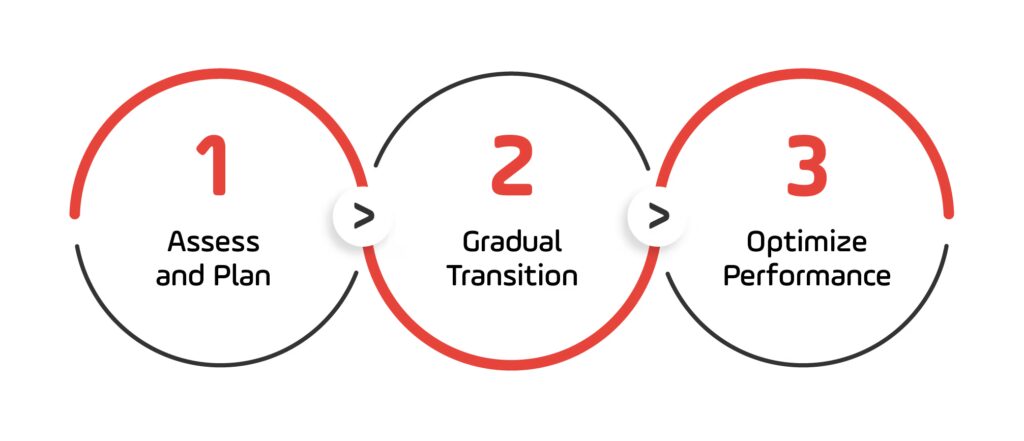
Migrating to JAMstack requires careful planning and execution, but when done right, it leads to faster performance, better security, and easier scalability. By following these best practices, businesses can successfully transition to a modern, API-driven architecture with minimal disruptions.
The Role of WebAssembly (WASM) in JAMstack
How WebAssembly Enhances JAMstack Performance
WebAssembly (WASM) is transforming modern web applications by allowing developers to run near-native speed code in the browser. In JAMstack architectures, WASM can improve performance-heavy applications, such as image processing, data visualization, and real-time analytics.
- Example: Running complex image manipulation tools directly in the browser without needing backend processing.
- Stat: According to Mozilla, WebAssembly executes up to 20 times faster than JavaScript in computational tasks.
Use Cases of WebAssembly
- High-performance data analysis: Running Python or Rust in WASM for advanced computations.
- Interactive web applications: Building 3D modeling tools, video editors, and gaming engines.
- Secure execution environments: Running sandboxed code in the browser to enhance security.
Future of WebAssembly
As more frameworks integrate WebAssembly, JAMstack will see increased adoption in industries requiring high-performance applications.
The Future of JAMstack Beyond 2025
What’s Next for JAMstack?
With continuous advancements in serverless computing, AI-driven automation, and decentralized hosting, JAMstack is poised to evolve beyond static site generation.
- AI-generated static sites: Using AI to pre-build personalized static pages dynamically.
- Blockchain integrations: Leveraging decentralized hosting solutions for enhanced security and reliability.
- Edge-first computing: Websites deploying directly from edge networks for ultra-low latency.
Predictions for JAMstack Adoption
- 75% of enterprise websites will adopt JAMstack by 2030 due to its scalability and performance.
- Serverless adoption will continue to rise, making traditional backends obsolete for many use cases.
JAMstack is no longer just about static sites—it’s evolving into a powerful ecosystem that redefines how web applications are built. Developers and businesses adopting AI, WebAssembly, and decentralized architectures will gain a competitive edge in the coming years.